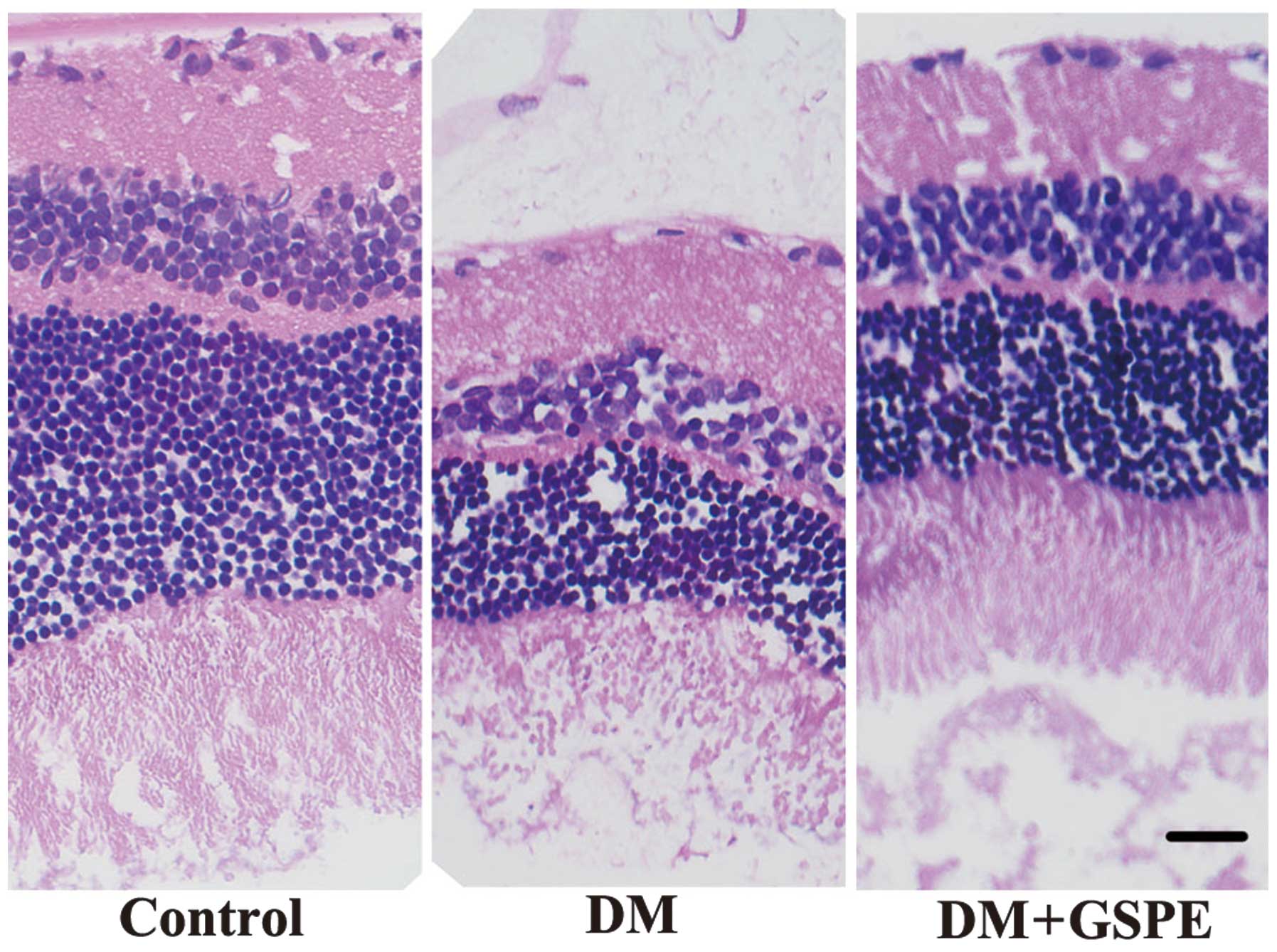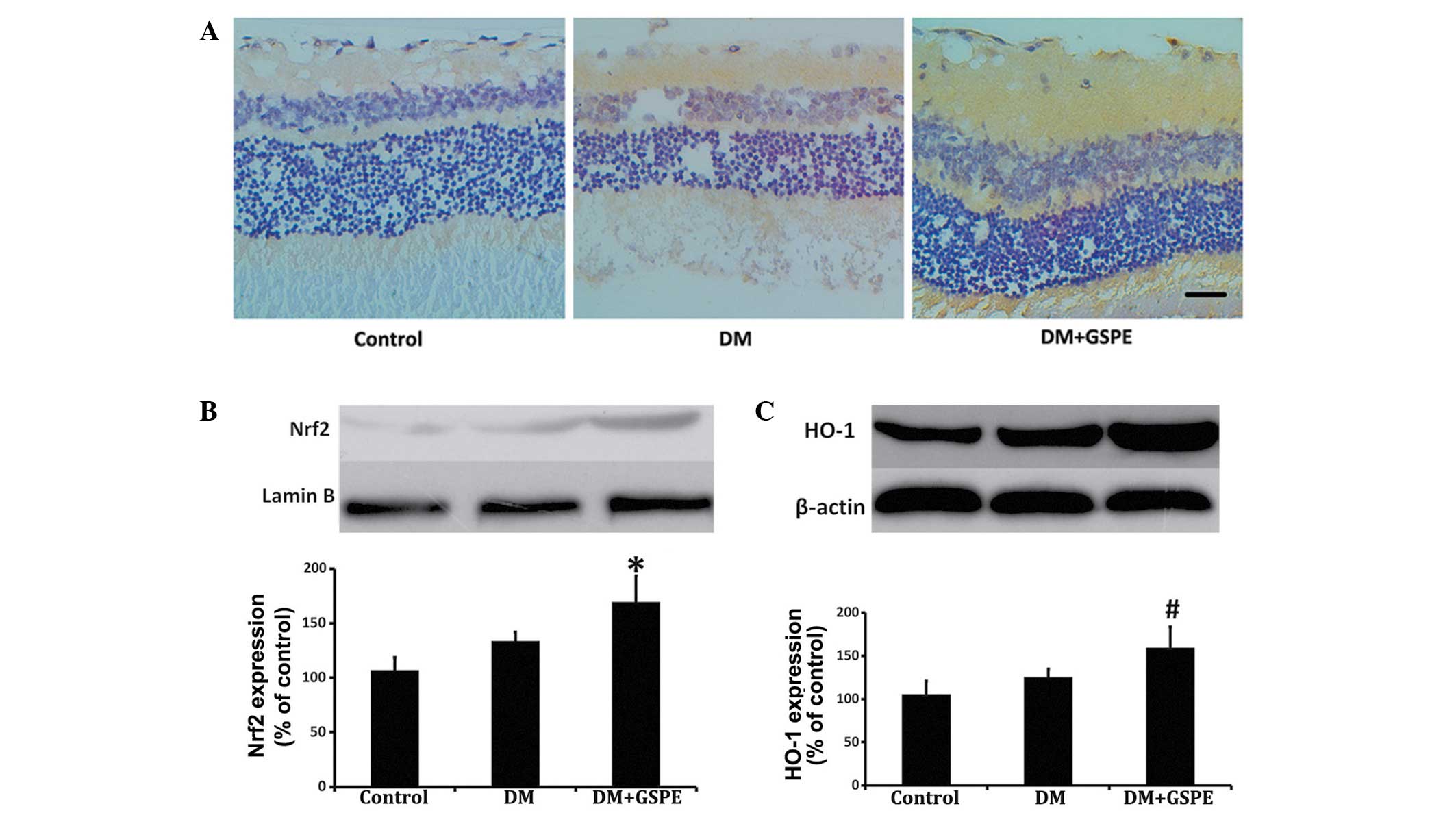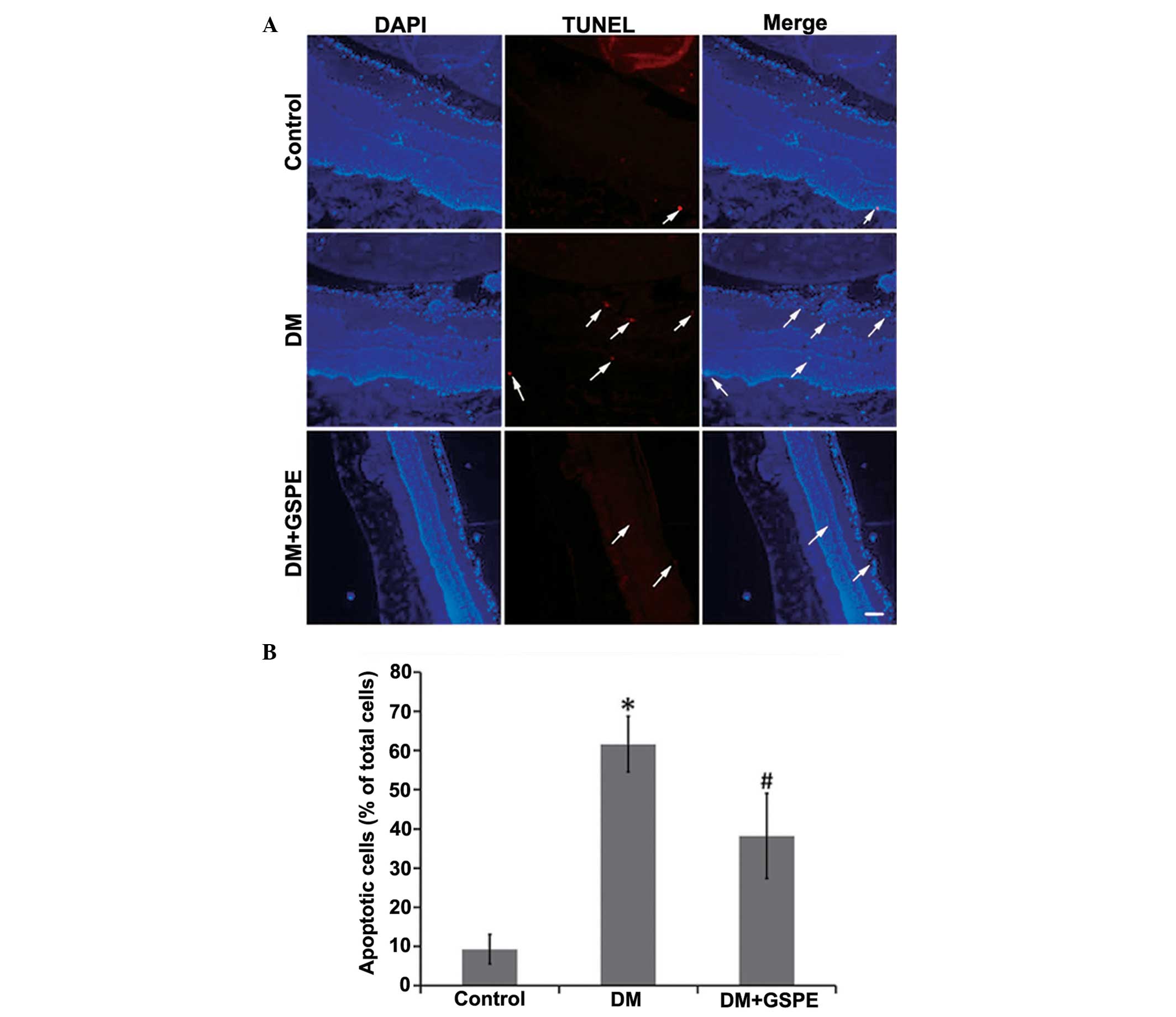|
1
|
Ruta LM, Magliano DJ, Lemesurier R, Taylor
HR, Zimmet PZ and Shaw JE: Prevalence of diabetic retinopathy in
Type 2 diabetes in developing and developed countries. Diabet Med.
30:387–398. 2013. View Article : Google Scholar : PubMed/NCBI
|
|
2
|
Man RE, Sasongko MB, Wang JJ, MacIsaac R,
Wong TY, Sabanayagam C and Lamoureux EL: The Association of
Estimated Glomerular Filtration Rate With Diabetic Retinopathy and
Macular Edema. Invest Ophthalmol Vis Sci. 56:4810–4816. 2015.
View Article : Google Scholar : PubMed/NCBI
|
|
3
|
Malek M, Khamseh ME, Aghili R, Emami Z,
Najafi L and Baradaran HR: Medical management of diabetic
retinopathy: An overview. Arch Iran Med. 15:635–640.
2012.PubMed/NCBI
|
|
4
|
Barber AJ, Gardner TW and Abcouwer SF: The
significance of vascular and neural apoptosis to the pathology of
diabetic retinopathy. Invest Ophthalmol Vis Sci. 52:1156–1163.
2011. View Article : Google Scholar : PubMed/NCBI
|
|
5
|
Hu WK, Liu R, Pei H and Li B: Endoplasmic
reticulum stress-related factors protect against diabetic
retinopathy. Exp Diabetes Res. 2012:5079862012. View Article : Google Scholar : PubMed/NCBI
|
|
6
|
Williams M, Hogg RE and Chakravarthy U:
Antioxidants and diabetic retinopathy. Curr Diab Rep. 13:481–487.
2013. View Article : Google Scholar : PubMed/NCBI
|
|
7
|
Ferreira D and Li XC: Oligomeric
proanthocyanidins: Naturally occurring O-heterocycles. Nat Prod
Rep. 17:193–212. 2000. View
Article : Google Scholar : PubMed/NCBI
|
|
8
|
Houde V, Grenier D and Chandad F:
Protective effects of grape seed proanthocyanidins against
oxidative stress induced by lipopolysaccharides of
periodontopathogens. J Periodontol. 77:1371–1379. 2006. View Article : Google Scholar : PubMed/NCBI
|
|
9
|
Li M, Ma YB, Gao HQ, Li BY, Cheng M, Xu L,
Li XL and Li XH: A novel approach of proteomics to study the
mechanism of action of grape seed proanthocyanidin extracts on
diabetic retinopathy in rats. Chin Med J (Engl). 121:2544–2552.
2008.PubMed/NCBI
|
|
10
|
Kaspar JW, Niture SK and Jaiswal AK:
Nrf2:INrf2 (Keap1) signaling in oxidative stress. Free Radic Biol
Med. 47:1304–1309. 2009. View Article : Google Scholar : PubMed/NCBI
|
|
11
|
Zhong Q, Mishra M and Kowluru RA:
Transcription factor Nrf2-mediated antioxidant defense system in
the development of diabetic retinopathy. Invest Ophthalmol Vis Sci.
54:3941–3948. 2013. View Article : Google Scholar : PubMed/NCBI
|
|
12
|
Xu Z, Wei Y, Gong J, Cho H, Park JK, Sung
ER, Huang H, Wu L, Eberhart C, Handa JT, et al: NRF2 plays a
protective role in diabetic retinopathy in mice. Diabetologia.
57:204–213. 2014. View Article : Google Scholar : PubMed/NCBI
|
|
13
|
Tan SM and De Haan JB: Combating oxidative
stress in diabetic complications with Nrf2 activators: How much is
too much? Redox Rep. 19:107–117. 2014. View Article : Google Scholar : PubMed/NCBI
|
|
14
|
Wang S, Park JK and Duh EJ: Novel targets
against retinal angiogenesis in diabetic retinopathy. Curr Diab
Rep. 12:355–363. 2012. View Article : Google Scholar : PubMed/NCBI
|
|
15
|
Scapagnini G, Vasto S, Abraham NG, Caruso
C, Zella D and Fabio G: Modulation of Nrf2/ARE pathway by food
polyphenols: A nutritional neuroprotective strategy for cognitive
and neurodegenerative disorders. Mol Neurobiol. 44:192–201. 2011.
View Article : Google Scholar : PubMed/NCBI
|
|
16
|
Jeong IK and King GL: New perspectives on
diabetic vascular complications: The loss of endogenous protective
factors induced by hyperglycemia. Diabetes Metab J. 35:8–11. 2011.
View Article : Google Scholar : PubMed/NCBI
|
|
17
|
Sun JK, Keenan HA, Cavallerano JD,
Asztalos BF, Schaefer EJ, Sell DR, Strauch CM, Monnier VM, Doria A,
Aiello LP and King GL: Protection from retinopathy and other
complications in patients with type 1 diabetes of extreme duration:
The joslin 50-year medalist study. Diabetes Care. 34:968–974. 2011.
View Article : Google Scholar : PubMed/NCBI
|
|
18
|
Kojima K, Maki K, Tofani I, Kamitani Y and
Kimura M: Effects of grape seed proanthocyanidins extract on rat
mandibular condyle. J Musculoskelet Neuronal Interact. 4:301–307.
2004.PubMed/NCBI
|
|
19
|
Mansouri E, Panahi M, Ghaffari MA and
Ghorbani A: Effects of grape seed proanthocyanidin extract on
oxidative stress induced by diabetes in rat kidney. Iran Biomed J.
15:100–106. 2011.PubMed/NCBI
|
|
20
|
Okudan N, Barışkaner H, Gökbel H, Sahin
AS, Belviranlı M and Baysal H: The effect of supplementation of
grape seed proanthocyanidin extract on vascular dysfunction in
experimental diabetes. J Med Food. 14:1298–1302. 2011. View Article : Google Scholar : PubMed/NCBI
|
|
21
|
Ding Y, Dai X, Jiang Y, Zhang Z, Bao L, Li
Y, Zhang F, Ma X, Cai X, Jing L, et al: Grape seed proanthocyanidin
extracts alleviate oxidative stress and ER stress in skeletal
muscle of low-dose streptozotocin- and high-carbohydrate/high-fat
diet-induced diabetic rats. Mol Nutr Food Res. 57:365–369. 2013.
View Article : Google Scholar : PubMed/NCBI
|
|
22
|
Cui XP, Li BY, Gao HQ, Wei N, Wang WL and
Lu M: Effects of grape seed proanthocyanidin extracts on peripheral
nerves in streptozocin-induced diabetic rats. J Nutr Sci Vitaminol
(Tokyo). 54:321–328. 2008. View Article : Google Scholar : PubMed/NCBI
|
|
23
|
Yamagishi S and Matsui T: Advanced
glycation end products (AGEs), oxidative stress and diabetic
retinopathy. Curr Pharm Biotechnol. 12:362–368. 2011. View Article : Google Scholar : PubMed/NCBI
|
|
24
|
Bagchi D, Sen CK, Ray SD, Das DK, Bagchi
M, Preuss HG and Vinson JA: Molecular mechanisms of
cardioprotection by a novel grape seed proanthocyanidin extract.
Mutat Res 523–524. 87–97. 2003. View Article : Google Scholar
|
|
25
|
Zou X, Feng Z, Li Y, Wang Y, Wertz K,
Weber P, Weber P, Fu Y and Liu J: Stimulation of GSH synthesis to
prevent oxidative stress-induced apoptosis by hydroxytyrosol in
human retinal pigment epithelial cells: Activation of Nrf2 and
JNK-p62/SQSTM1 pathways. J Nutr Biochem. 23:994–1006. 2012.
View Article : Google Scholar : PubMed/NCBI
|
|
26
|
Pehar M, Vargas MR, Robinson KM, Cassina
P, Díaz-Amarilla PJ, Hagen TM, Radi R, Barbeito L and Beckman JS:
Mitochondrial superoxide production and nuclear factor erythroid
2-related factor 2 activation in p75 neurotrophin receptor-induced
motor neuron apoptosis. J Neurosci. 27:7777–7785. 2007. View Article : Google Scholar : PubMed/NCBI
|
|
27
|
Fan J, Xu G, Jiang T and Qin Y:
Pharmacologic induction of heme oxygenase-1 plays a protective role
in diabetic retinopathy in rats. Invest Ophthalmol Vis Sci.
53:6541–6556. 2012. View Article : Google Scholar : PubMed/NCBI
|
|
28
|
He M, Pan H, Chang RC, So KF, Brecha NC
and Pu M: Activation of the Nrf2/HO-1 antioxidant pathway
contributes to the protective effects of Lycium barbarum
polysaccharides in the rodent retina after ischemia reperfusion
induced damage. PloS One. 9:e848002014. View Article : Google Scholar : PubMed/NCBI
|

















